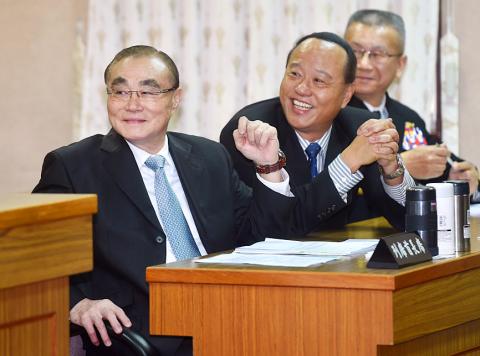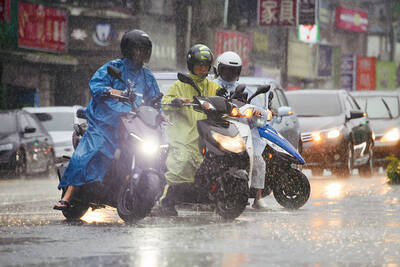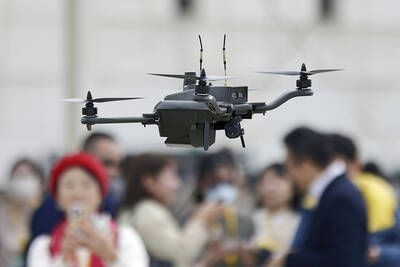The Ministry of National Defense plans to acquire new-generation stealth fighter jets with short or vertical takeoff and landing capabilities to deter Chinese military action against Taiwan, it said in its Quadrennial Defense Review released yesterday.
The military plans to procure the jets to improve its asymmetrical capabilities, as the cross-strait military balance has increasingly tilted in China’s favor, the report said.
It also plans to develop indigenous submarines and upgrade surface vessels, improve air-defense missile and road-mobile missile systems, and establish a fleet of uncrewed aerial combat vehicles.

Photo: Chien Jung-fong, Taipei Times
Any jets capable of short or vertical takeoff and landing could be the ministry’s target, including, but not exclusively, the Lockheed Martin F-35, Deputy Minister of National Defense Lee Hsi-ming (李喜明) said during a question-and-answer session at the legislature’s Foreign Affairs and National Defense Committee meeting in Taipei.
The ministry disputed reports that AGM-154 Joint Standoff Weapon systems and AGM-88 high-speed anti-radiation missiles are in an arms package for Taiwan to be approved by US President Donald Trump following his meeting with Chinese President Xi Jinping (習近平), which is scheduled for early next month in Florida.
“All those claims are media speculation,” ministry spokesman Major General Chen Chung-chi (陳中吉) said. “The nation would carefully assess [what weapons are necessary] according to regional threats and defense requirements.”
The report presents defense guidelines for a “solid defense and multi-layered deterrents,” aiming to deter the enemy from waging war and, if deterrence fails, to launch a series of counterstrikes to destroy the incoming enemy at sea or on beaches.
“With the rapid growth of China’s defense budget, the People’s Liberation Army has made considerable progress to modernize and reform its military,” the review said. “It has the ability to blockade Taiwan, launch combined operations, and seize and hold Taiwan’s outlying islands.”
Lieutenant General Chiang Chen-chung (姜振中), director of the ministry’s Office for Operations and Planning, said the armed forces have the capability to launch a counteroffensive and attack China if necessary.
Asked if the armed forces could defend against multiple attacks launched from bases as far as 1,300km from Taiwan, Chiang said the military “has such ability and there are plans and training in place.”
Legislators said the report was overwhelmingly similar to the 2013 review and the ministry had failed to clarify its plans to acquire advanced weapons or develop the local defense industry.
Democratic Progressive Party (DPP) Legislator Tsai Shih-ying (蔡適應) said there was little difference between the two reports in terms of the air force’s capabilities and cybersecurity measures.
Chinese Nationalist Party (KMT) Legislator Hsu Yu-jen (許毓仁) and DPP Legislator Chuang Jui-hsiung (莊瑞雄) said the review failed to expound on the ministry’s efforts to build a cyberwarfare command as a fourth branch of the military.
Major General Li Ting-sheng (李廷盛), director of the ministry’s Office for Communications, Electronics and Information, said that a cyberwarfare unit would be set up in the second half of this year to protect the military’s command, control, communications, computers, intelligence, surveillance and reconnaissance systems, as well as key infrastructure.
Plans to develop a local defense industry, in particular the aerospace, shipbuilding and information security sectors, is what distinguishes this year’s review from previous ones, the ministry said.
Meanwhile, Minister of National Defense Feng Shih-kuan (馮世寬) said that a small defense budget and increasing difficulty in maintaining an all-voluntary force as the nation’s birth rate declines are the biggest hurdles to improving the nation’s defensive capabilities.
Defense spending should be increased to 3 percent of the GDP, but the defense budget for this year of NT$355.7 billion (US$11.6 billion) is only 2.05 percent of GDP, Feng said.

The combined effect of the monsoon, the outer rim of Typhoon Fengshen and a low-pressure system is expected to bring significant rainfall this week to various parts of the nation, the Central Weather Administration (CWA) said. The heaviest rain is expected to occur today and tomorrow, with torrential rain expected in Keelung’s north coast, Yilan and the mountainous regions of Taipei and New Taipei City, the CWA said. Rivers could rise rapidly, and residents should stay away from riverbanks and avoid going to the mountains or engaging in water activities, it said. Scattered showers are expected today in central and

COOPERATION: Taiwan is aligning closely with US strategic objectives on various matters, including China’s rare earths restrictions, the Ministry of Foreign Affairs said Taiwan could deal with China’s tightened export controls on rare earth metals by turning to “urban mining,” a researcher said yesterday. Rare earth metals, which are used in semiconductors and other electronic components, could be recovered from industrial or electronic waste to reduce reliance on imports, National Cheng Kung University Department of Resources Engineering professor Lee Cheng-han (李政翰) said. Despite their name, rare earth elements are not actually rare — their abundance in the Earth’s crust is relatively high, but they are dispersed, making extraction and refining energy-intensive and environmentally damaging, he said, adding that many countries have opted to

SUPPLY CHAIN: Taiwan’s advantages in the drone industry include rapid production capacity that is independent of Chinese-made parts, the economic ministry said The Executive Yuan yesterday approved plans to invest NT$44.2 billion (US$1.44 billion) into domestic production of uncrewed aerial vehicles over the next six years, bringing Taiwan’s output value to more than NT$40 billion by 2030 and making the nation Asia’s democratic hub for the drone supply chain. The proposed budget has NT$33.8 billion in new allocations and NT$10.43 billion in existing funds, the Ministry of Economic Affairs said. Under the new development program, the public sector would purchase nearly 100,000 drones, of which 50,898 would be for civil and government use, while 48,750 would be for national defense, it said. The Ministry of

UNITED: The other candidates congratulated Cheng on her win, saying they hoped the new chair could bring the party to victory in the elections next year and in 2028 Former Chinese Nationalist Party (KMT) lawmaker Cheng Li-wun (鄭麗文) yesterday won the party’s chair election with 65,122 votes, or 50.15 percent of the votes. It was the first time Cheng, 55, ran for the top KMT post, and she is the second woman to hold the post of chair, following Hung Hsiu-chu (洪秀柱), who served from 2016 to 2017. Cheng is to succeed incumbent Eric Chu (朱立倫) on Nov. 1 for a four-year term. Cheng said she has spoken with the other five candidates and pledged to maintain party unity, adding that the party would aim to win the elections next year and